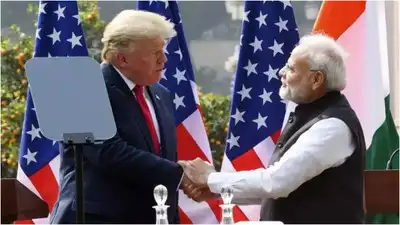
US President Donald Trump and Prime Minister Narendra Modi (File Image)
NEW DELHI: Trade talks between India and the US appear to be back on track, as President Donald Trump hinted that a "very big" agreement with India will be forthcoming soon. In a presser at the White House, Trump said, "Everybody wants to make a deal and have a part of it.
Remember a few months ago, the press was saying, 'You really have anybody of any interest? Well, we just signed with China yesterday.
We are having some great deals. We have one coming up, maybe with India. Very big one. Where we're going to open up India, in the China deal, we are starting to open up China.""We're not going to make deals with everybody. Some we are just going to send them a letter, say thank you very much. You are to pay 25, 35, 45 per cent.
That's the easy way to do it, and my people don't want to do it that way. They want to do some of it, but they want to make more deals than I would do," he added.
Impact on agriculture, tariff and energy
The trade relationship between India and the United States is expected to transform significantly, might lower tariffs, making US products more competitive in India, particularly in energy, agriculture, defence and aviation sectors. Given India's higher average tariffs compared to the US, the BTA could give advantage to American exporters, according to the Finance Ministry's Monthly Economic Review.
The US implemented a 26% reciprocal tariff on Indian products in April 2025 but suspended it for 90 days from April 10, maintaining a 10% basic duty. Bilateral discussions have accelerated, showing substantial progress in digital trade, market access, customs procedures, and technical standards. A provisional agreement might be reached before July 9, as India seeks complete exemption from retaliatory tariffs.India-US trade reached $131.84 billion in FY25, establishing India as the US's primary trading partner. CRISIL suggests that while US imports to India might increase under the BTA, Indian exports may see limited benefits, as numerous key exports already enjoy duty-free access to the US market.India's growing energy requirements, especially for LNG, could create beneficial partnerships with US suppliers. CRISIL highlights LNG's advantages in price stability and long-term contract suitability over crude oil.
Agricultural imports from the US might increase, including walnuts, pistachios and cranberries, although broader access remains disputed.The defence sector presents significant growth opportunities. Despite India's focus on domestic defence production, it remains a major arms importer. The US, as the world's leading arms exporter, has strengthened defence collaboration with India, including the INDUS-X programme initiated in 2023.Although India's trade surplus might face pressure, CRISIL identifies growth potential in labour-intensive industries like textiles, gems and jewellery, alongside high-value sectors such as smartphones and pharmaceuticals. The BTA negotiations encompass multiple sectors, with both nations considering it a crucial step towards enhanced economic partnership.Prime Minister Narendra Modi and Trump reached an agreement in February to finalise the initial phase of a bilateral trade deal by autumn 2025, with plans to increase trade to $500 billion by 2030, up from approximately £191 billion in 2024.India continues to progress in its negotiations with the European Union for a free trade agreement later this year, and has recently completed discussions for a FTA with the United Kingdom. These initiatives aim to diversify trade partnerships in anticipation of possible US policy changes under Trump."The ball is now in the US court. India is not for any win-lose trade partnership," stated Ram Singh, who leads the Indian Institute of Foreign Trade, a government-supported research organisation.Data shows India's exports to the US increased to $17.25 billion during April-May, compared to $14.17 billion in the previous year, indicating that the US tariff increases averaging 10% in early April had minimal effect.

 5 hours ago
52
5 hours ago
52




























 English (US)
English (US)